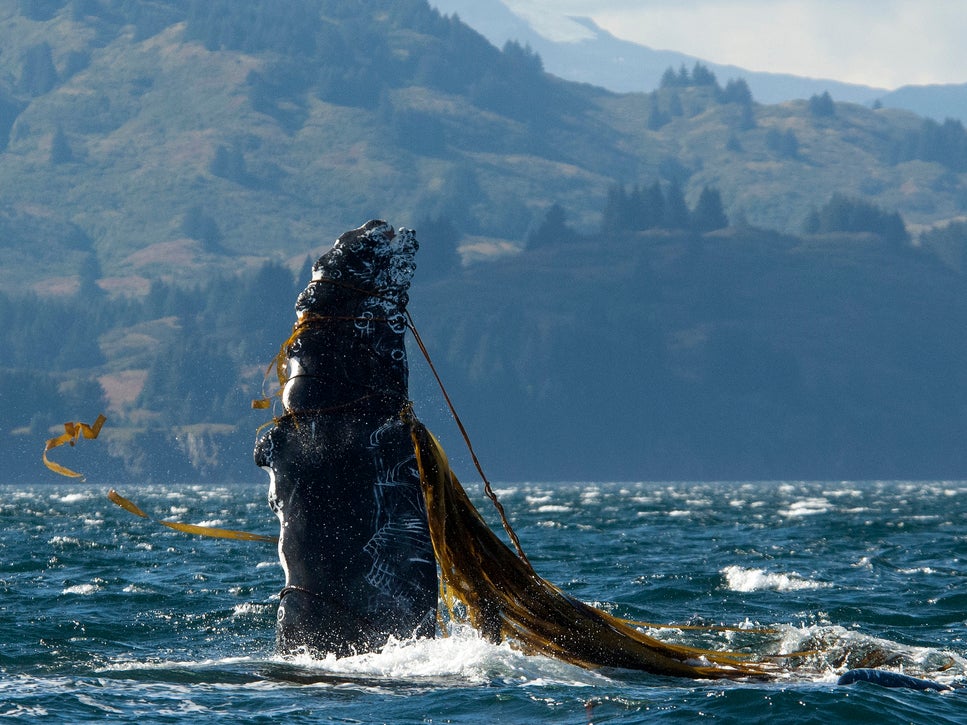This website uses cookies so that we can provide you with the best user experience possible. Cookie information is stored in your browser and performs functions such as recognising you when you return to our website and helping our team to understand which sections of the website you find most interesting and useful.

The warming of the oceans due to climate change may be helping to drive an “unprecedented” spike in the number of whales found entangled in fishing gear, scientists have said.
Increasing global average temperatures are believed to be responsible for increasing both the frequency and intensity of marine heatwaves. A major heatwave on the US west coast between 2014-16 saw record entanglements of humpback and other whales recorded.
The rise in entanglements is thought to have occurred because the warmer waters meant whales had moved to feed in an area closer to the coast which is used for crab fishing, according to a study published in the journal Nature.
The research team has called for new measures to alert fishermen to the risk of entanglements and help managers adjust to more rapid and frequent changes in the marine environment.
“With the ocean warming, we saw a shift in the ecosystem and in the feeding behaviour of humpback whales that led to a greater overlap between whales and crab fishing gear,” said Jarrod Santora, a research scientist at NOAA Fisheries’ Southwest Fisheries Science Centre (SWFSC) in Santa Cruz, California, and lead author of the research.
“We need to put information in the hands of those who can use it, at a time when it can make a difference,” he added. “We are seeing changes coming at us in ways they never have before.”
1/13
Mom and calf humpback whales make their way toward the surface in Tonga.
Getty Images
2/13
salto della megattera durante whale watching in islanda, salto della balena, incredibile
Getty Images/iStockphoto
3/13
An aerial photo of humpback whales in a pod
Getty Images/iStockphoto
4/13
Humpback mother and calf, with a snorkeler, in Tonga.
Getty Images/iStockphoto
5/13
Humpback Whale breaching out of water in the morning light in Iceland
Getty Images/iStockphoto
6/13
humpback whales playing on surface in the blue between Tahiti and Moorea
Getty Images/iStockphoto
7/13
A beached grey whale which died after an effort by local fishermen to pull her back out to sea. San Juanico, Baja California Sur, Mexico.
Getty Images/iStockphoto
8/13
White Beluga Whale is looking at the camera from underwater.
Getty Images/iStockphoto
9/13
An orca chases herrings on January 17, 2019, in the Reisafjorden fjord region, near the Norwegian northern city of Tromso in the Arctic Circle. (Photo by Olivier MORIN / AFP) (Photo credit should read OLIVIER MORIN/AFP/Getty Images)
AFP/Getty Images
10/13
TOPSHOT - An orca chases herrings on January 14, 2019, in the Reisafjorden fjord region, near the Norwegian northern city of Tromso in the Arctic Circle. (Photo by Olivier MORIN / AFP) (Photo credit should read OLIVIER MORIN/AFP/Getty Images)
AFP/Getty
11/13
A Humpback whale jumps in the surface of the Pacific Ocean at the Uramba Bahia Malaga National Natural Park in Colombia, on August 12, 2018. - Humpback whales (Megaptera novaeangliae) migrate annually from the Antarctic Peninsula to peek into the Colombian Pacific Ocean coast, with an approximate distance of 8,500 km, to give birth and nurse their young. Humpback whales have a life cycle of 50 years or so and is about 18 meters long. (Photo by Miguel MEDINA / AFP) (Photo credit should read MIGUEL MEDINA/AFP/Getty Images)
AFP/Getty Images
12/13
A Humpback whale jumps in the surface of the Pacific Ocean at the Uramba Bahia Malaga National Natural Park in Colombia, on August 12, 2018. - Humpback whales (Megaptera novaeangliae) migrate annually from the Antarctic Peninsula to peek into the Colombian Pacific Ocean coast, with an approximate distance of 8,500 km, to give birth and nurse their young. Humpback whales have a life cycle of 50 years or so and is about 18 meters long. (Photo by Miguel MEDINA / AFP) (Photo credit should read MIGUEL MEDINA/AFP/Getty Images)
AFP/Getty Images
13/13
A whale surfaces on July 8, 2018 just east of Montauk, New York in the Block Island Sound.
Getty Images
1/13
Mom and calf humpback whales make their way toward the surface in Tonga.
Getty Images
2/13
salto della megattera durante whale watching in islanda, salto della balena, incredibile
Getty Images/iStockphoto
3/13
An aerial photo of humpback whales in a pod
Getty Images/iStockphoto
4/13
Humpback mother and calf, with a snorkeler, in Tonga.
Getty Images/iStockphoto
5/13
Humpback Whale breaching out of water in the morning light in Iceland
Getty Images/iStockphoto
6/13
humpback whales playing on surface in the blue between Tahiti and Moorea
Getty Images/iStockphoto
7/13
A beached grey whale which died after an effort by local fishermen to pull her back out to sea. San Juanico, Baja California Sur, Mexico.
Getty Images/iStockphoto
8/13
White Beluga Whale is looking at the camera from underwater.
Getty Images/iStockphoto
9/13
An orca chases herrings on January 17, 2019, in the Reisafjorden fjord region, near the Norwegian northern city of Tromso in the Arctic Circle. (Photo by Olivier MORIN / AFP) (Photo credit should read OLIVIER MORIN/AFP/Getty Images)
AFP/Getty Images
10/13
TOPSHOT - An orca chases herrings on January 14, 2019, in the Reisafjorden fjord region, near the Norwegian northern city of Tromso in the Arctic Circle. (Photo by Olivier MORIN / AFP) (Photo credit should read OLIVIER MORIN/AFP/Getty Images)
AFP/Getty
11/13
A Humpback whale jumps in the surface of the Pacific Ocean at the Uramba Bahia Malaga National Natural Park in Colombia, on August 12, 2018. - Humpback whales (Megaptera novaeangliae) migrate annually from the Antarctic Peninsula to peek into the Colombian Pacific Ocean coast, with an approximate distance of 8,500 km, to give birth and nurse their young. Humpback whales have a life cycle of 50 years or so and is about 18 meters long. (Photo by Miguel MEDINA / AFP) (Photo credit should read MIGUEL MEDINA/AFP/Getty Images)
AFP/Getty Images
12/13
A Humpback whale jumps in the surface of the Pacific Ocean at the Uramba Bahia Malaga National Natural Park in Colombia, on August 12, 2018. - Humpback whales (Megaptera novaeangliae) migrate annually from the Antarctic Peninsula to peek into the Colombian Pacific Ocean coast, with an approximate distance of 8,500 km, to give birth and nurse their young. Humpback whales have a life cycle of 50 years or so and is about 18 meters long. (Photo by Miguel MEDINA / AFP) (Photo credit should read MIGUEL MEDINA/AFP/Getty Images)
AFP/Getty Images
13/13
A whale surfaces on July 8, 2018 just east of Montauk, New York in the Block Island Sound.
Getty Images
Dr Santora and his colleagues are developing a website that will use oceanographic data to forecast the areas where whales are most likely to be feeding off the US west coast.
Crab fishermen will then be able to use the information to help decide where, and where not, to set their traps. It may also help managers decide where and when to open or close fishing.
The numerous entanglements have prompted environmental lawsuits which threaten to restrict crab fishing. A focus on entanglements and better research into their causes has also led to improved communication between fishermen, environmental groups, and managers.
“If the working group knew then what we know now, it wouldn’t have happened,” said John Mellor, a crab fisherman from San Francisco, speaking about the increased entanglements. “The more we understand the whole picture, the better chance we have to mitigate the impacts.”
The marine heatwave which took hold in 2014 became known as “the warm blob”, because of the large expanse of unusually high temperatures that dominated waters off the west coast. Higher temperatures attracted subtropical species rarely seen in the region and the krill humpback whales typically feed on grew scarce.
The whales switched to feed instead on high concentrations of anchovy which the warm, less productive waters had squeezed into a narrow band near the coast.
At the same time, the higher temperatures fuelled a record bloom of toxic algae. This shut down crabbing on the west coast from November 2015 until March 2016. When toxin levels eased and the Dungeness season finally opened, fishermen set multitudes of crab traps in that same narrow band where many whales were feeding closer to shore.
NOAA Fisheries’ west coast region confirmed a then-record 53 whale entanglements in 2015 and 55 in 2016.
Research Biologist Karin Forney, also from the SWFSC and a co-author of the research, lives in Moss Landing, California. She has a view of Monterey Bay and has regularly seen humpback whales feeding just offshore. During the “blob” years, she would regularly see 30 to 40 whales from her front windows.
“In our lifetimes living here, that was unprecedented,” she said. “We knew something dramatically different was pulling these whales closer to shore.”
Dr Forney said the lesson of the research was that scientists and fishermen must share more information to help each other understand how complex environmental connections affect marine species and fisheries.
The research is published in Nature Communications.



 Africana55 Radio
Africana55 Radio 

